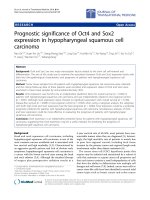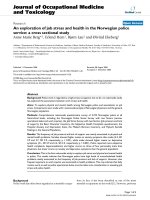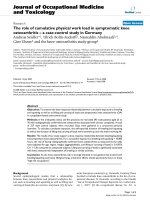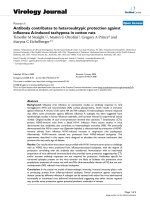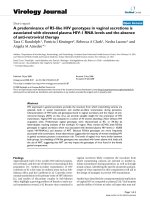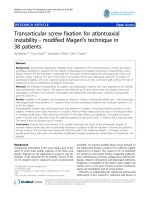Báo cáo hóa học: " First-Principles Study of Magnetic Properties of 3d Transition Metals Doped in ZnO Nanowires" potx
Bạn đang xem bản rút gọn của tài liệu. Xem và tải ngay bản đầy đủ của tài liệu tại đây (384.58 KB, 5 trang )
NANO IDEAS
First-Principles Study of Magnetic Properties of 3d Transition
Metals Doped in ZnO Nanowires
Hongliang Shi Æ Yifeng Duan
Received: 1 October 2008 / Accepted: 22 January 2009 / Published online: 11 February 2009
Ó to the authors 2009
Abstract The defect formation energies of transition
metals (Cr, Fe, and Ni) doped in the pseudo-H passivated
ZnO nanowires and bulk are systematically investigated
using first-principles methods. The general chemical trends
of the nanowires are similar to those of the bulk. We also
show that the formation energy increases as the diameter of
the nanowire decreases, indicating that the doping of
magnetic ions in the ZnO nanowire becomes more difficult
with decreasing diameter. We also systematically calculate
the ferromagnetic properties of transition metals doped in
the ZnO nanowire and bulk, and find that Cr ions of the
nanowire favor ferromagnetic state, which is consistent
with the experimental results. We also find that the ferro-
magnetic coupling state of Cr is more stable in the
nanowire than in the bulk, which may lead to a higher T
c
useful for the nano-materials design of spintronics.
Keywords First-principles Á Transition-metals Á
Formation energies Á Nanowires Á Magnetism
Introduction
The utilization of the charge freedom degree of electrons in
semiconductors to describe the transportation properties
and of the spin freedom degree of electrons in magnetic
materials to store the information is separated. Until Ohno
reports that ferromagnetism can be achieved in (Ga,Mn)As
system by introducing magnetic ions Mn into GaAs matrix
[1], which invokes great interests in the diluted magnetic
semiconductors (DMSs) because of the utilization of both
the charge and spin freedom degrees of electrons in these
materials [2, 3]. Both theoretical and experimental inves-
tigations are performed extensively due to the great
potential applications of DMSs in spintronic devices
[4–10]. However, one difficulty for the applications is that
the Curie temperatures (T
c
) of most DMSs materials are
below the room temperature. Many attempts have been
performed to find high T
c
DMSs materials [11–14]. Sato
and Katayama-Yoshida [11] have systematically investi-
gated the ferromagnetic properties of transition metals
(TMs) doped in ZnO based DMSs using first principles
calculations, and suggested that the Cr-doped ZnO is one
candidate for high T
c
ferromagnetic DMSs. Nano-scaled
DMSs have also been reported recently [12–14]. The Cr-
doped single-crystalline nanowires with the stable room-
temperature ferromagnetism have been successfully fabri-
cated [14]. However, the origin of the ferromagnetism is
still under debate. The Zener model has been proposed to
explain the interaction between the TM ions [15]. In
addition, wei et al. also proposed a band coupling model
based on p-d and d-d repulsions between TM ions and host
elements to explain the origin of the ferromagnetism using
first-principles band structure calculations [16, 17].
Recently, experimental investigations show that the
doping is more difficult in the nanosized structures than in
the bulk semiconductors, leading to the low solubility of
the dopant [18–22]. So far, the origin of this doping diffi-
culty in the nanosized structures is still not clear. Since
the concentration of the charge carriers in the nanosized
H. Shi (&)
State Key Laboratory for Superlattices and Microstructures,
Institute of Semiconductors, Chinese Academy of Sciences,
P.O. Box 912, Beijing 100083, People’s Republic of China
e-mail:
Y. Duan
Department of Physics, School of Sciences,
China University of Mining and Technology,
Xuzhou 221008, People’s Republic of China
e-mail:
123
Nanoscale Res Lett (2009) 4:480–484
DOI 10.1007/s11671-009-9260-7
ZnO-based DMSs is important for their applications, it is of
great interest to investigate the chemical trends of defect
formation and magnetic couplings of TMs doped in the
ZnO nanowire theoretically.
In this letter, we systematically calculate the defect
formation energies and magnetic coupling properties of
transition metals (Cr, Fe, and Ni) doped in the ZnO
nanowire and bulk. We find that the two nearest Cr atoms
favor ferromagnetic state, which is more stable in the
nanowire than in the bulk case. We also find that Cr and Fe
can be doped in the ZnO nanowire more easily than Ni due
to their lower formation energies, and favor ferromagnetic
states.
The paper is organized as follows. In Sect. ‘‘Calcula-
tional Methods and Details’’, we describe our calculational
methods and details. In Sect. ‘‘Results and Discussion’’ , w e
discuss the defect formation energies of transition metals in
ZnO nanowires and bulk, and the magnetic coupling
properties of the TMs in the two systems. A brief summary
of the letter is given in Sect. ‘‘Summary’’ .
Calculational Methods and Details
Our total energy calculations are performed using the
density functional theory (DFT) in the generalized gradient
approximation (GGA) of PW91 functional [23] for the
exchange correlation potential and the projector augmented
wave (PAW) method [24] as implemented in the Vienna
ab initio simulation package [25]. The electron wave
function is expanded in plane waves up to a cutoff energy
of 300 eV, and all the geometries are fully relaxed until the
quantum mechanical forces acting on the atoms become
less than 0.01 eV/A
˚
. We used only the C point for the k
points-sampling in the nanowire calculations. The ZnO
nanowire of 1.0 nm diameter is generated from the
7 9 7 9 2 supercell of bulk wurtzite (WZ) ZnO along the
[0001] direction. The outside of the nanowire within the
7 9 7 9 2 supercell is vacuum space to avoid the inter-
action between the nanowires in the neighboring
supercells. The supercell selected here has a periodical
length of 2c, where c is the bulk lattice parameter along the
[0001] direction. We use the pseudo-H to passivate the
dangling bonds of Zn and O atoms on the surface of the
nanowire [26]. Our nanowire supercell for ferromagnetic
calculations contains 48 Zn, 48 O, 24 H
1.5
and 24 H
0.5
atoms, as shown in Fig. 1a.
The defect system is modeled by putting one or two
defects into supercell mentioned above. To determine the
defect formation energy, we calculate the total energy
E(a,0) for the supercell containing the relaxed defect a in
neutral state, and the total energy E(ZnO) for the host ZnO
nanowire in the absence of the defect as well as the total
energies of the elemental solids. The defect formation
energy DH
f
(a,0) is defined as [27]
DH
f
ða; 0Þ¼DEð a; 0Þþn
Zn
l
Zn
þ n
O
l
O
þ n
A
l
A
; ð1Þ
where
DEð a; 0Þ¼Eða; 0ÞÀEðZnOÞþn
Zn
l
0
Zn
þ n
a
l
0
a
: ð2Þ
l
i
is the chemical potential of constituent i relative to
element solid with chemical potential l
i
0
[28, 29]. The n
i
’s
are the number of Zn and extrinsic defects a. For com-
parison, we also investigate bulk case doped with the same
impurities with 2 9 2 9 2 supercell of WZ containing 16
Zn atoms and 16 O atoms, as shown in Fig. 1b, and the
Brillouin zone integration is performed with 4 9 4 9 4
k-meshpoints for the bulk magnetic calculations.
In our previous work, we have systematically studied the
ferromagnetic properties of Mn ions doped in the ZnO
nanowire in different configurations, and found that the
ferromagnetic coupling between the Mn ions exists in
the ZnO nanowire with unpassivated surfaces while not in
the nanowire with passivated surfaces [30]. In order to
exclude the surface states locating in the band gap, which
may have effects on the ferromagnetism and are not present
in the passivated case, we passivate the nanowire using
pseudo-H atoms. Our calculated band gaps are 2.24 and
0.8 eV for the passivated nanowire with the diameter of
1.0 nm and bulk case, respectively.
Results and Discussion
Formation Energies of the Defects in ZnO Nanowires
and Bulk
The defect formation energy DH
f
(a,0) of defect a in neutral
state determines the dopant solubility in a host at given
growth conditions. Generally, high formation energy leads
to low solubility. The defect formation energy DH
f
(a,0) of
Fig. 1 a The ZnO nanowire unit-cell and b bulk unit-cell are studied
here. The grey spheres are Zn, yellow are O, red are H
1.5
, and blue are
H
0.5
. The green spheres are the Zn sites substituted with Cr atoms or
other TM atoms. The geometry is before relaxation
Nanoscale Res Lett (2009) 4:480–484 481
123
TMs doped in the ZnO nanowires and bulk is calculated
using Eq. 1 in the defect rich condition, i.e., l
i
= 0. The
calculated relative formation energy DH
f
(a,0) of the neutral
transition metal impurities doped in nanowires and bulk are
shown in Fig. 2, indicating that the chemical trends of
defect energy are similar in the two cases. For the nano-
wire, the formation energies for Cr and Fe are lower,
leading to the higher doping concentration. For the case of
Cr, the formation energy difference between nanowire and
bulk is 0.131 eV. The diameter of the nanowire we studied
here is 1.0 nm. In order to investigate, the nanosize effect
on the formation energy, we also calculate the formation
energies of TMs doped in the smallest nanowire with
diameter of 0.65 nm (see Fig. 2). The formation energies
increase as the size of the nanowire decreases. Therefore,
the doping in the nanowires with the smaller diameter
becomes more difficult, which is similar to the case of
nanocrystals (in our calculation, we ignored the spin–orbit
(S–O) coupling interation, thus only the states with the
same spin can couple with each other. To the first order,
including the S–O coupling will not change the quantity
much. Further reference can be found in [31]). The varia-
tions of formation energies could be explained by the shift
of the single electron energy levels of 3d relative to the
conduction band minimum (CBM) and valence band
maximum (VBM) due to the quantum confinement effect.
Magnetic Couplings between the Transition Metals
in ZnO Nanowire and Bulk
In order to find whether ferromagnetic (FM) coupling
between TM atoms exists in the nanowire with the diam-
eter of 1 nm, we substitute two Zn atoms with two TM
atoms with the nearest distance (the two TM atoms are the
in-plane nearest neighbors and the plane is perpendicular to
the c axis). Therefore, the transition metal concentration is
4.2%. For comparison, we also study the bulk case with the
TMs concentration of 12.5%. Figure 1 shows the supercells
and the TMs substitutional sites. For each configuration,
both ferromagnetic and anti-ferromagnetic (AFM) states
are calculated. According to the energy difference DE
between the total energy of AFM and FM states, we can
find which state is more favored. The positive (negative)
DE means that the FM (AFM) state is more stable. The
calculated results are listed in Table 1. In the nanowire, Cr
and Fe favor ferromagnetic states energetically, and Co and
Ni prefer anti-ferromagnetic states, whereas the opposite is
only true for the cases of Fe and Ni in the bulk.
Based on the band coupling model, Walsh et al. inves-
tigated the ferromagnetism of Co-doped ZnO using DFT?
U
d/s
to correct the band gap error by applying a Coulomb U
on both the s and d orbitals to further raise the CBM level
[9]. The correct picture of TMs 3d levels in the nanowire at
the C point can be obtained due to the enlarged band gap
resulting from the quantum confinement effect, even if the
gap is not accurate enough. Note that our calculated band
gap of the pure passivated nanowire is 2.24 eV. Based on
the crystal field theory, the TMs 3d states split into one
triply degenerate t
2
state and one doubly generate e state in
zinc-blende (ZB) structures. The t
2
states further split into
one doubly degenerate e state and one singly a
1
state due to
the lower point group C
3v
in the WZ. The O 2p levels also
split into e and a
1
states. Figure 3 shows the schematic plot
of the Cr 3d levels in majority spin at C point in the bulk
and nanowire band structures.
Based on the band coupling model, the d–dcoupling of
ZnO or GaN based DMSs dominates the ferromagnetism
Fig. 2 The calculated relative defect formation energies DH
f
(a,0) of
the neutral transition metal impurities in ZnO nanowires of different
diameters and bulk case. (All the formation energies take reference to
the formation energy of Cr doped in the bulk ZnO)
Table 1 The total energy difference DE (DE = E
AFM
-E
FM
)
between AFM and FM states for each configuration is showed in the
second column
Configuration DE (eV) Coupling Mag(TM
1
) Mag(TM
2
)
Nanowire
ZnCrO 0.275 FM 2.779 2.914
ZnFeO 0.031 FM 3.494 3.532
ZnCoO -0.239 AFM 2.238 -2.241
ZnNiO -0.041 AFM 1.229 -1.219
Bulk
ZnCrO 0.243 FM 3.112 3.105
ZnFeO -0.163 AFM 3.488 -3.510
ZnCoO -0.090 AFM 2.404 -2.392
ZnNiO 0.188 FM 1.552 1.548
The third column gives the preferred magnetic coupling between the
TM atoms. The fourth and fifth columns give the magnetic moments
(l
B
) of two TM atoms. The minus magnetic moments indicate that the
two TMs have opposite spin
482 Nanoscale Res Lett (2009) 4:480–484
123
behavior due to the fact that the 3d levels are above the
VBM [17]. Figure 4 shows two kinds of magnetic coupling
between two Cr atoms in the nanowire. Since the energy
levels have included the p–d interaction, the d levels con-
tain the p character, and vice versa. For the FM coupling
between the two Cr atoms in Fig. 4a, there is an energy
gained because the highest e levels in the majority spin
channels are half occupied. In minority spin channels, one
e level is pushed up and the other is pushed down by the
same amount (denoted as the double exchange D
dd
1
).
Therefore, there is no energy gained due to the empty
occupation. For the AFM coupling in Fig. 4b, the e level of
one Cr ion with majority spin couples with that of the other
Cr ion with the same spin (denoted as the super-exchange
D
dd
1,2
)[31], and there is also energy gained due to the half
occupation of the e levels. Since the energy gained from
the double exchange interaction is larger than that from the
super-exchange interaction due to the existence of large
exchange splitting e
dd
, the FM states are favored in the Cr-
doped ZnO nanowire, which is also true for the Fe doped in
ZnO nanowire. However, for the case of Co, the highest
occupied e is fully occupied and there is energy gained
from the super-exchange interaction, as a result, the AFM
state is favored. Note that our calculated results of TMs
doped in the nanowire are consistent with the theoretical
analysis. To further understand the origin of ferromagne-
tism of TMs in the ZnO nanowire, we also plot the density
of states (DOS) of 3d levels of the FM and AFM states in
Fig. 5 for the two Cr and two Co ions, respectively.
Furthermore, we also show that the FM state of Cr is
more stable in the nanowire than that in the bulk, which can
be interpreted by the fact that compared with the case of Cr
doped in the bulk, in the nanowire, the p–d repulsion in the
Fig. 3 The schematic plot for the the Cr 3d levels in majority spins at
C point in the bulk and nanowires band structures
(a)
(b)
Fig. 4 The schematic view of the ferromagnetic coupling and anti-
ferromagnetic coupling between the two Cr atoms doped in ZnO
nanowires. The 3d levels are showed and the energy levels include the
p–d interaction. The line with the double-headed arrow indicates that
the two states with the same spin channel couple with each other
(a) (e)
(f)(b)
(c)
(d) (h)
(g)
Fig. 5 The DOS of 3d levels for a, b two Cr ions in their FM
coupling state, c, d two Co ions in their FM coupling state, e, f two Cr
ions in their AFM coupling state, g, h two Co ions in their AFM
coupling state
Nanoscale Res Lett (2009) 4:480–484 483
123
nanowire becomes weaker and the exchange splitting e
dd
increases due to low concentration of Cr and the VBM
moving down. Since the superexchange D
dd
1,2
term decrea-
ses, which favors to the anti-ferromagnetic state, and the
FM stabilization energy D
dd
1
does not significantly change,
the ferromagnetic state is more stable in the nanowire.
The total energy difference DE (DE = E
AFM
-E
FM
)of
0.275 eV for the Cr-doped nanowire is bigger than that of
0.243 eV for the Cr-doped bulk, suggesting that the former
has a higher T
c
. Since the high T
c
is crucial to the spintronic
devices, our calculated results could be useful in nano-
materials design for spintronics.
Summary
In summary, we have investigated the formation energies
of TMs (Cr, Fe, and Ni) doped in the ZnO nanowires and
bulk using first-principles total energy methods. The
chemical trends are similar in the two systems. We also
find that the formation energies increase as the diameter of
the nanowire decreases, indicating that the doping becomes
more difficult with decreasing diameter. Finally, it is found
that the ferromagnetic state of Cr doped is more stable in
nanowires than in the bulk, leading to a higher T
c
indis-
pensable to the spintronic devices.
Acknowledgments This work was supported by the National Basic
Research Program of China (973 Program) grant No. G2009CB929300
and the National Natural Science Foundation of China under Grant
Nos. 60521001 and 60776061. Part of the CPU time was performed in
Supercomputing Center, Chinese Academy of Sciences.
References
1. H. Ohno, Science 281, 951 (1998)
2. M.H. Huang, S. Mao, H. Feick, H.Q. Yan, Y.Y. Wu, H. Kind,
E. Weber, R. Russo, P. Yang, Science 292, 1897 (2001)
3. T. Dietl, H. Ohno, F. Matsukura, J. Cibert, D. Ferrand, Science
287, 1021 (2000)
4. D. Karmakar, S.K. Mandal, R.M. Kadam, P.L. Paulose,
A.K. Rajarajan, T.K. Nath, A.K. Das, I. Dasgupta, G.P. Das,
Phys. Rev. B 75, 144404 (2007)
5. J. Alaria, M. Bouloudenine, G. Schmerber, S. Colis, A. Dinia,
P. Turek, M. Bernard, J. Appl. Phys. 99, 08M118 (2006)
6. P. Gopal, N.A. Spaldin, Phys. Rev. B 74, 094418 (2006)
7. H. Katayama-Yoshida, K. Sato, T. Fukushima, M. Toyoda,
H. Kizaki, V.A. Dinh, P.H. Dederichs, Phys. Status Solidi A 204,
15 (2007)
8. A. Walsh, J.L.F. Da Silva, S H. Wei, Phys. Rev. Lett. 100,
256401 (2008)
9. Y. Duan, H. Shi, L. Qin, Phys. Lett. A 372, 2930 (2008)
10. Y. Duan, J. Li, S S. Li, J B. Xia, J. Appl. Phys. 103, 023705
(2008)
11. K. Sato, H. Katayama-Yoshida, Semicon. Sci. Technol. 17, 367
(2002)
12. H.J. Xiang, S H. Wei, Nano Lett. 8, 1825 (2008)
13. Q. Wang, Q. Sun, P. Jena, Nano Lett. 5, 1587 (2005)
14. D. Chu, Y P. Zeng, D. Jiang, Solid State Commun. 143, 308
(2007)
15. T. Dietl, H. Ohno, F. Matsukura, J. Cibert, D. Ferrand, Science
287, 1019 (2000)
16. S H. Wei, G.M. Dalpian, Proc. SPIE 6894, 68940L (2008)
17. G.M. Dalpian, S H. Wei, X.G. Gong, A.J.R. da Silva, A. Fazzio,
Solid State Commun. 138, 353 (2006)
18. M. Shim, P. Guyot-Sionnest, Nature 407, 981 (2000)
19. F.V. Mikulec, M. Kuno, M. Bennati, D.A. Hall, R.G. Griffin,
M.G. Bawendi, J. Am. Chem. Soc. 122, 2532 (2000)
20. D.J. Norris, N. Yao, F.T. Charnock, T.A. Kennedy, Nano Lett. 1,
3 (2001)
21. S.C. Erwin, L. Zu, M.I. Haftel, A.L. Efros, T.A. Kennedy,
D.J. Norris, Nature 436, 91 (2005)
22. G.M. Dalpian, J.R. Chelikowsky, Phys. Rev. Lett. 96, 226802
(2006)
23. Y. Wang, J.P. Perdew, Phys. Rev. B 44, 13298 (1991)
24. G. Kresse, D. Joubert, Phys. Rev. B 59, 1758 (1999)
25. G. Kresse, J. Furthmuller, Phys. Rev. B 54, 11169 (1996)
26. L.W. Wang, J.B. Li, Phys. Rev. B 69, 153302 (2004)
27. S.B. Zhang, J.E. Northrup, Phys. Rev. Lett. 67, 2394 (1991)
28. S H. Wei, S.B. Zhang, Phys. Rev. B 66, 155211 (2002)
29. S H. Wei, Comput. Mater. Sci. 30
, 337 (2004)
30. H. Shi, Y. Duan, J. Appl. Phys. 103, 073903 (2008)
31. A.J.R. da Silva, A. Fazzio, R.R. dos Santos, L.E. Oliveira,
J. Phys. Condens. Matter 16, 8243 (2004)
484 Nanoscale Res Lett (2009) 4:480–484
123
